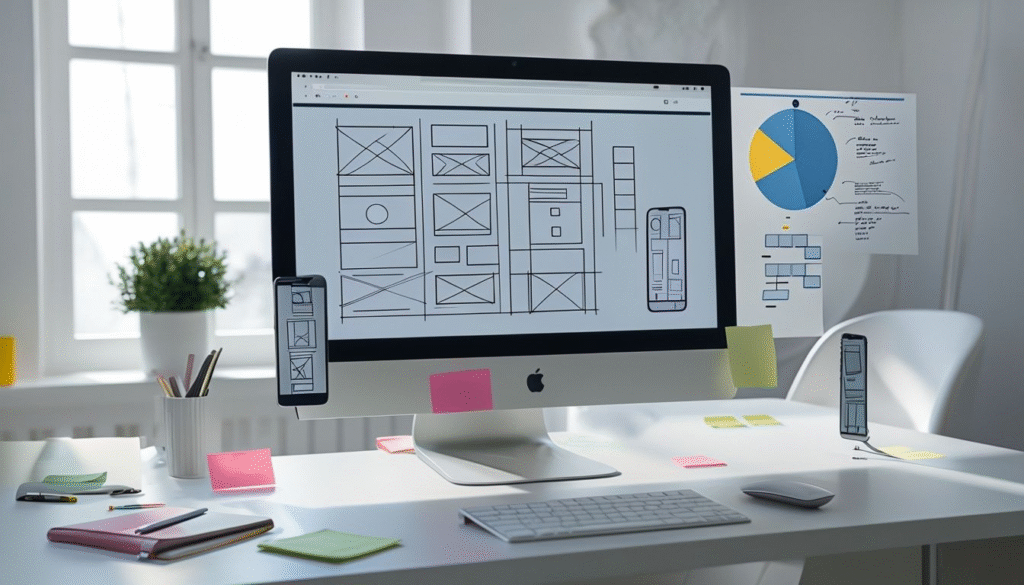

Why UX Is Your Silent Dealbreaker
In the digital world, you don’t get second chances. A user lands on your website, clicks around for a few seconds, and if the experience is clunky, confusing, or slow, they’re gone.
User Experience (UX) has become a business-critical element, not just a design concern. A well-optimized UX reduces friction, builds trust, and drives conversions. Meanwhile, poor UX does the exact opposite. In this blog, we’ll uncover seven hidden ways your UX may be sabotaging your sales, and more importantly, how to fix it. We’ll also explore key UX principles, actionable tools, and examples that will help you turn user frustration into user loyalty.
1. Confusing Navigation = Lost Visitors
The Problem: When users can’t find what they’re looking for, they leave. Navigation menus overloaded with options, vague labels, or inconsistent layouts add unnecessary friction.
Symptoms:
- High bounce rates
- Low time on site
- Users frequently using the search bar as a last resort
Solution:
- Use a clear hierarchy and limit top-level menu items to 5-7
- Group related pages logically
- Test your nav flow with real users
UX Tip: Simplify. Remove or demote anything not mission-critical.
Additional Insight: Consider implementing sticky navigation for long pages and breadcrumb trails for better user orientation.
2. Slow Load Speeds Drive Drop-Offs
The Problem: Speed is a conversion killer. Each additional second in page load time dramatically increases bounce rate.
Causes:
- Unoptimized images
- Heavy third-party scripts
- Poor server performance
Solution:
- Use tools like Google Page Speed Insights to find bottlenecks
- Compress media files, lazy-load below-the-fold content
- Move to a CDN or upgrade your hosting plan
Stat: A 1-second delay in load time can result in a 7% reduction in conversions.
Pro Insight: Preload key assets and use asynchronous loading for JavaScript files to further optimize performance.
3. Poor Mobile Optimization
The Problem: With over 60% of global website traffic coming from mobile, a desktop-first site alienates the majority of users.
Common Issues:
- Tiny text
- Buttons that are hard to tap
- Layouts that break on small screens
Solution:
- Design mobile-first
- Prioritize content hierarchy for small screens
- Use flexible grids and test on various devices
Bonus: Mobile-friendly design is a Google ranking factor.
Pro Tip: Leverage responsive frameworks like Bootstrap or Tailwind to speed up development.
4. Frustrating Forms Kill Leads
The Problem: Your form is your conversion gate. Complex, lengthy, or error-prone forms repel users.
Symptoms:
- High drop-off rate on checkout or sign-up pages
- Incomplete or inaccurate submissions
Solution:
- Ask only for essential information
- Use smart defaults and auto-complete
- Provide inline validation and helpful error messages
Pro Tip: Break long forms into smaller, multi-step forms. This can increase completions by up to 30%.
Case Example: A client reduced their 14-field sign-up form to 6 fields and saw a 42% boost in sign-ups in just 3 weeks.
5. Inconsistent Visual Design Erodes Trust
The Problem: Clashing fonts, misaligned elements, and erratic styling confuse and discredit your brand.
Impact:
- Users question legitimacy
- Drop in perceived professionalism
- Decreased return visits
Solution:
- Create a consistent design system
- Standardize font types, colors, and spacing
- Audit every page for visual continuity
Rule of Thumb: Consistency breeds confidence.
UX Detail: Establish a UI style guide and reusable component library to maintain consistency across projects.
6. No Clear Visual Hierarchy
The Problem: When everything on the page screams for attention, nothing stands out. Users struggle to understand what’s important.
Common Mistakes:
- Uniform font sizes
- Random placement of buttons or CTAs
- No clear focal point
Solution:
- Use contrast, size, and position to guide attention
- Highlight CTAs through spacing and color
- Establish predictable reading paths (F-pattern, Z-pattern)
Reminder: Design for scan-ability, not just readability.
Design Hack: Apply the 60/30/10 color rule to balance attention and brand consistency in your design.
7. Ignoring User Feedback and Behavior
The Problem: Making design decisions based solely on assumptions is dangerous. User behavior tells a clearer story.
Missed Opportunities:
- No usability testing
- Not tracking scrolls, clicks, or rage-clicks
- Lack of exit intent analysis
Solution:
- Use tools like Hotjar, Clarity, or FullStory for heatmaps and session recordings
- Run monthly UX surveys or feedback pop-ups
- Iterate often based on real feedback
Smart Move: Good UX is never “set it and forget it”. It evolves with your users.
Additional Step: Set up session replays for key funnels to observe drop-off points and optimize iteratively.
What Great UX Looks Like in Action
A user-first digital experience:
- Loads in under 3 seconds
- Seamlessly adapts across devices
- Guides users clearly from entry to conversion
- Delivers feedback at every step
- Is visually aligned with the brand’s message
Bonus Checklist:
- Clear CTA above the fold
- Short, compelling copy
- Fast checkout flow
- Product reviews visible
- Trust badges at decision points
Case Study Example: After redesigning their mobile checkout with improved UX (fewer steps, clearer CTA, faster load time), an eCommerce client increased their mobile conversion rate by 48% in 90 days.
UX Beyond Conversions: Building Loyalty and Advocacy
Good UX is not just about the first click. It’s about the return visit, the referral, and the brand memory left behind. Great UX creates:
- Positive emotional response
- Long-term brand loyalty
- Higher customer lifetime value
Did You Know? 88% of online consumers are less likely to return after a bad experience. Meanwhile, a seamless UX can increase customer satisfaction by up to 83%.
UX = Competitive Edge.
How We Can Help You Fix It
At Plutonic Services, we design digital products and websites that convert better by putting users first. Our UX experts conduct audits, run real-user tests, and rebuild interfaces that don’t just look good they work.
Explore our projects.
Want to stop losing users to poor UX? Let’s build something that actually works for them and for your business.


